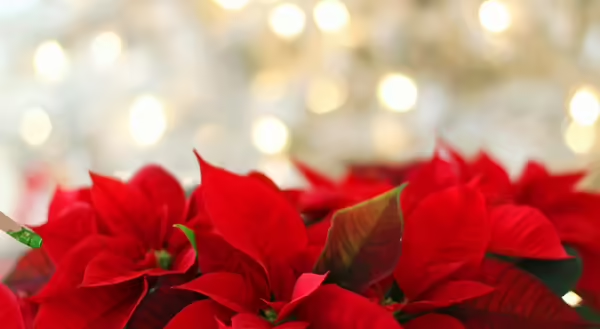
This holiday season, buy Poinsettias from local growers, and keep them vibrant with a few “don’ts” from a previous Poinsettia greenhouse grower.
Millions of Poinsettias are bought each year as decoration and gifts. What most consumers do not know is Poinsettias have to be grown with a lot of love and attention or they won’t make it to your holiday festivities.
They require the absolute ideal environment to grow in, a task far more complex and tedious than other crops grown in the greenhouse. The growing tasks involve strict water and fertilizer regiment to encourage good root growth but not too much top growth, followed by applications of plant growth regulators if the plants get too tall and leggy. While growing this crop, the management of pests brings huge limitations, and getting a full display of colorful bracts by market date requires curtains to blackout all light every night. (Bracts are the showy colored parts of Poinsettias that are often referred to as flowers but are actually modified leaves.) The Poinsettias growing requirements must be carefully tended to on a daily basis for several weeks for a successfully colorful crop.
The ideal Poinsettia plant is short and has large colorful bracts. It would seem that after so much fuss during the growing process, the care of these plants would be too difficult for a consumer. However, a few easy tips on what not to do with your holiday treasure can have your plant flourishing throughout the holiday season.
- Don’t buy Poinsettias whose flowers are opened. The small, yellow flowers are located in the center of the bracts. They should still be tightly closed when purchasing.
- Do not put Poinsettias in direct sunlight. They will stay fresher with a few hours of indirect light each day.
- Do not place Poinsettias near heating vents or doors. Poinsettias stay the freshest in a cool room, away from drafts. Temperatures should be no lower than 55°F and no higher than 70°F. The ideal temperature to keep these plants healthy and colors more vibrant is 65°F.
- Do not water a Poinsettia on a regiment but only when it is dry. Let Poinsettia plants dry out between watering. If there is any weight when you pick up the container, wait another day to water, but do not let the soil recede from the side of the plants. Both insufficient water and too much water will cause the lower leaves to yellow and drop. Never let Poinsettia plants sit in saucers of water or foil wraps, but opt for watering and draining in a bucket or the kitchen sink.
- Do not expose Poinsettia to cold temperatures. Most greenhouses/ garden centers wrap Poinsettias for transport. Do not leave Poinsettias in your car or outside for prolonged periods. Sudden temperature fluctuations will cause poinsettias to drop their leaves.
- Do not expect to keep them as houseplants after the holidays. Although some do and are very successful, it is the strict growing requirements listed above that can make it a difficult task for the typical plant enthusiast. The typical holiday Poinsettia lasts about 8 weeks. Elect to keep other holiday favorites like Christmas cactus, Kalanchoe, and amaryllis bulbs that can make interesting house plants.
- Do not be afraid that Poinsettias are toxic to your animals. Although care should be taken to prevent ingestion, Poinsettias are only considered mildly toxic, and serious complications are rare.
- Do not be afraid of colors that are not red. Try something new year--appreciate the beauty and variation of these holiday plants!
Find more information on the Illinois Extension Poinsettia website.